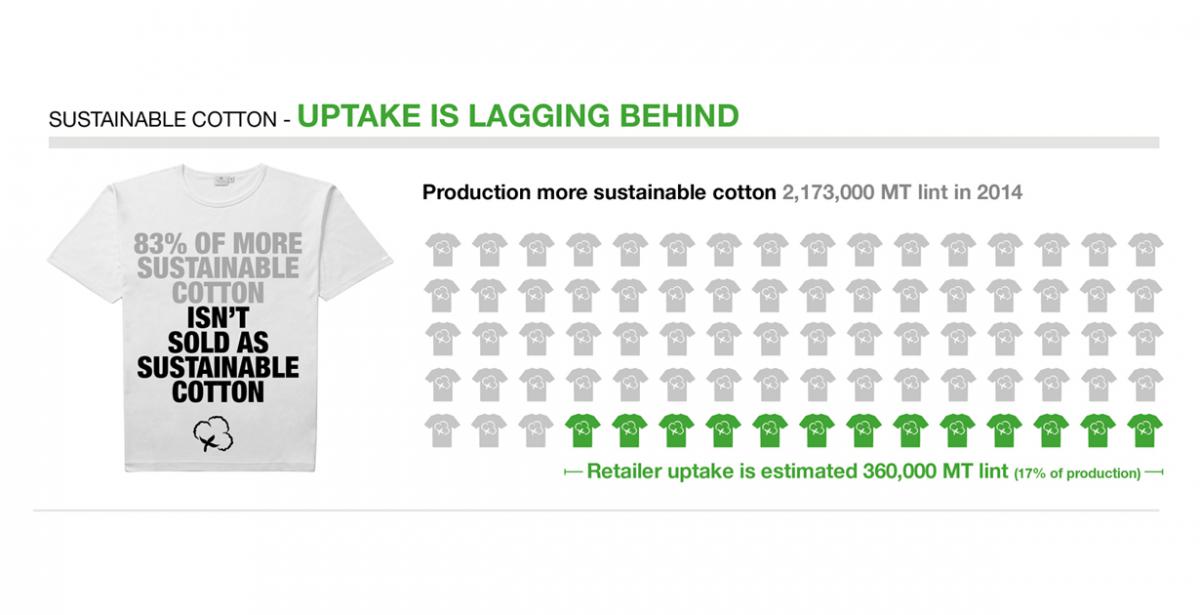Production of more sustainable cotton has never been higher, reaching 2,173,000 tonnes in 2014 or 8% of the total global supply. This is projected to rise to 13% in 2015. Richard Holland, director of the WWF Market Transformation Initiative, said, “Buying more sustainable cotton has never been easier. Leading companies like IKEA and H&M are showing it’s possible to use 100% more sustainable cotton in their products within a couple of years.”

But a study by independent researcher Simon Ferrigno has found that uptake is lagging behind with only 17% of all sustainable cotton being bought by retailers. The remaining 83% is diverted to the conventional cotton market, which can act as a disincentive to farmers to invest in sustainable cotton production. If greater demand is not reflected in increased orders from retailers, there is a danger that farmers will abandon sustainable production altogether and the opportunity to improve global standards will be missed. Isabelle Roger, senior manager for the cotton programme at Solidaridad comments, “Lots more sustainable cotton is available but shockingly it is not being sourced and bought as sustainable cotton.”
Cotton is a key raw material for textiles
Cotton is grown in around 80 countries worldwide and is a key raw material for the textile industry, representing around 32% of all fibres used. Around 33 million hectares around the world are planted with cotton, accounting for 2.5% of global arable land, and cotton is a core sector in the economies of developing countries such as Mali, where it made up 60% of exports in 2013. Sustainability issues include the widespread use of pesticides with 6.2% of global pesticide sales associated with cotton production. Environmental impacts such as loss of biodiversity, soil erosion and contamination have intensified as cotton has increasingly been produced as a monocrop with 73% of global production currently dependent on irrigation.
Cotton needs cleaning up. Conventional production requires the use of large amounts of water and pesticides. Sourcing more sustainable cotton is the best way forward. – Keith Tyrell, Director at Pesticide Action Network UK
Sustainable cotton production also has the potential to lift farmers out of poverty by providing a more stable income and improving working conditions. The US Department of Labor reported in 2014 that child labour or forced labour existed in the cotton production process in 18 countries, including five of the top six producer nations (China, India, Pakistan, Brazil and Uzbekistan). When world cotton prices fell by 40% in 2001/02, rural poverty in cotton-growing regions of Benin increased by 8%. Many farmers are also driven into debt by the cost of pesticides and fertiliser
s.
Sustainable cotton standards
A number of sustainable cotton standards have been developed in the last 30 years, starting with Organic cotton in the 1980s, followed by Fairtrade in 2004, Cotton made in Africa (CmiA) in 2005 and the Better Cotton Initiative (BCI) in 2009. All of them provide guidance and support for farmers and reassure consumers and retailers that the products they buy are being produced using sustainable farming methods. However, the gap between uptake and supply is widening and at present the bulk of more sustainable cotton ends up on the conventional market.
Research to compare company performance has started
At least 12 companies have made commitments to source 100% more sustainable cotton, including IKEA, which reported reaching this milestone in 2015. Nevertheless, further commitments and increased market uptake are essential if more sustainable cotton production is to remain attractive and viable for farmers.
PAN UK, Solidaridad and WWF will continue to make the ethical and business case for sourcing more sustainable cotton to global fashion and textile companies through research and campaigning. Regular research will benchmark companies and take note of the most recent trends in the production and uptake of more sustainable cotton.
Download the full report here.
Or contact us today to speak directly with one of our experts.
